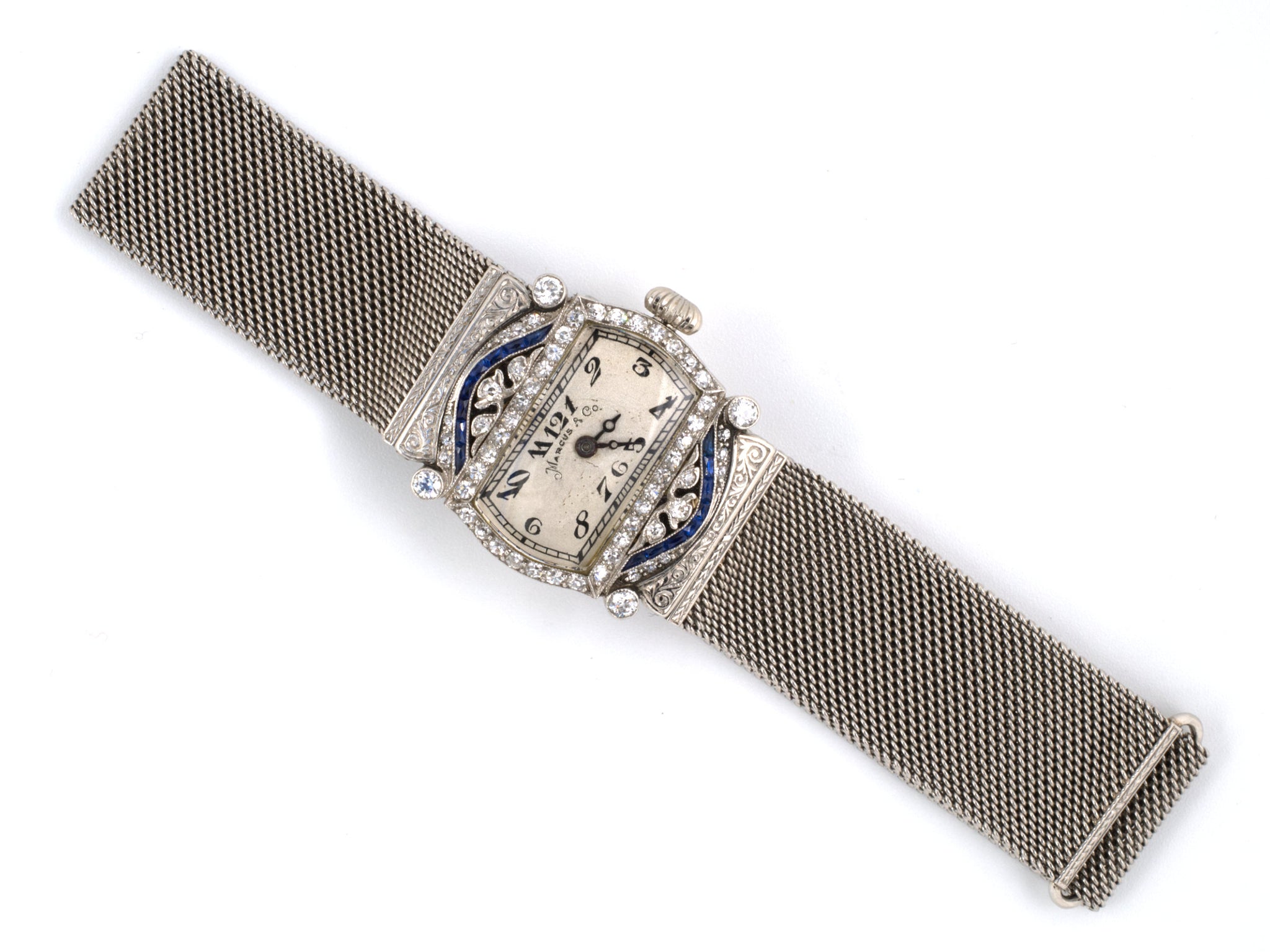Marcus & Co
Herman Marcus was born in Germany on December 25th 1829, and his arrival in New York City in 1850 would mark the beginning of a Jewelry business that would last for close to a century. Despite having worked several early jobs at Tiffany & Co. and Ball Black & Co., Marcus’ career would truly take off with the start of his partnership with Theodore B. Starr in 1864. They quickly established themselves as a unique business, not only for the pieces they created but also for their presentation. The custom at the time being to showcase jewelry, Marcus and Starr instead kept their merchandise in safes, only displaying pieces “on a long counter, covered with soft billiard cloth” (Zapata) when a client expressed interest. This practice helped give their business an air of mystery and expertise.

21086 - Edwardian Marcus Wreath Pin
In addition to artistic jewelry and stone cameos, they sold bronzes, clocks, elaborate silverware and medals ordered by Congress for distinguished military and naval services. But it was their work with diamonds for which they were most noted. By the 1870’s silverware was thriving and they were one of the five firms chosen to submit a design in a competition for a presentation vase gifted to American poet William Bryant in celebration of his 80th birthday. Unfortunately many of their pieces are unknown, potentially gathering dust in antique cabinets or destroyed by the passage of time. Marcus and Starr’s partnership dissolved in 1877 and he returned to Tiffany & Co.

61109 - Art Deco Marcus Platinum Diamond Watch
In 1884 Herman Marcus joined the firm Jaques & Marcus which was comprised of his son William Elder Marcus and partner George B. Jaques. Jaques & Marcus became known for their work with colored gemstones, which had been largely ignored by jewelers. One such example was the use of Alexandrite, a rare gemstone whose color changes depending on the light it reflects (i.e. green in daylight, dark purplish red in artificial light). They were also known for several unique pieces containing exceedingly rare colored diamonds. Unfortunately, many of these have since been taken apart, their stones re-used in more “modern” settings. Jaques & Marcus became Marcus & Co upon Jaques’ retirement in 1892.

61229 - Circa 1890 Marcus C.H. Meylan Gold Pocket Watch
Herman Marcus died on October 18th 1899, at the age of 71. His obituary mentioned him not only “developing the artistic in the [jewelry] business” (Zapata), but also the deep respect and admiration he had garnered over the years. Marcus & Co continued to thrive under the leadership of his two sons William and George. Having moved to its final location on 5th Avenue, they announced the opening of a Department for Silversmithing. The silverware produced was usually stamped with the words “Marcus & Co” or “Sterling”, but a few rare pieces featured “a cursive M enclosed in a rectilinear frame resting on a curved stand” (Zapata). Their use of the cut en cabochon made many of their silver pieces more distinctive, and for their hollowware (i.e. metal tableware) they came up with a variation of the Japanese art mokume, which consisted of applying solder on the silver to form the design, then rolling on gold, copper, and niello to make strips. As one article at the time noted, “each piece of Marcus & Co jewelry was meticulously conceived with subtleties that are often not perceived at first, but become apparent upon closer inspection” (Zapata). They were known for both their “imaginative and inventive designs” and “more traditional, elegant jewelry”.

21308 - Art Deco Marcus Platinum Pearl Sapphire Diamond Crystal Pin
When William retired in 1920, his two sons, William Elder Marcus Jr. and Chapin Marcus, took over. They were more interested in gemstones and pearls, and in order to gain better access to these stones, established offices in Paris, London, and Bombay. They were also known for the many ways in which they incorporated emeralds in their pieces: faceted, en cabochon, engraved with floral motifs – the latter of which became somewhat of a house specialty.

71758 - Art Deco Marcus Oscar Heyman Platinum Diamond Ruby Bracelet
On January 17th 1934, the Jonker rough, a stone weighing 726 carats, was unearthed in South Africa. Diamond importer Harry Winston bought the stone, and had it cut into 12 diamond pieces – one of which was dubbed the Marcus-Jonker when William Jr. bought it in 1936.

900778 - Art Deco Marcus Platinum Sapphire Diamond Engagement Ring
Inspired by the art modern movement flora began to be treated in a more stylized manner and become a central part of Marcus & Co’s window displays. While most jewelry houses displayed their pieces traditionally, Marcus was known for their imaginative displays designed by William Bayard Okie Jr, reflecting miniature stage sets. One memorable display consisted of a blackened window with only three portholes showing vignettes representing moonlight, starlight, and daylight featuring pieces set with moonstones, star sapphires, and opals.
During World War II retail challenges and a 10% tax on luxury goods resulted in the selling of their company to Gimbel Brothers Department Store in 1941. A jewelry dynasty for over 90 years, Marcus & Co remains a renowned name, their pieces of consistently high quality, emblematic of the periods in which they were made and many now on display in museums across the country.
Sources:
Antiques Magazine, August 2007
The Legacy of Herman Marcus and Marcus & Company – Janet Zapata
